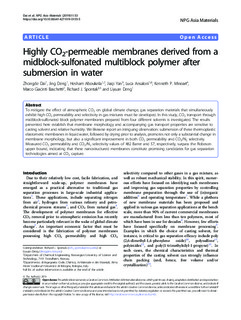| dc.contributor.author | Dai, Zhongde | |
| dc.contributor.author | Deng, Jing | |
| dc.contributor.author | Aboukeila, Hesham | |
| dc.contributor.author | yuan, jiaqi | |
| dc.contributor.author | Ansaloni, Luca | |
| dc.contributor.author | Mineart, Kenneth P. | |
| dc.contributor.author | Baschetti, Marco Giacinti | |
| dc.contributor.author | Spontak, Richard J | |
| dc.contributor.author | Deng, Liyuan | |
| dc.date.accessioned | 2019-10-31T07:40:57Z | |
| dc.date.available | 2019-10-31T07:40:57Z | |
| dc.date.created | 2019-10-30T14:26:51Z | |
| dc.date.issued | 2019 | |
| dc.identifier.citation | NPG Asia Materials. 2019, 11 (53), . | nb_NO |
| dc.identifier.issn | 1884-4049 | |
| dc.identifier.uri | http://hdl.handle.net/11250/2625495 | |
| dc.description.abstract | To mitigate the effect of atmospheric CO2 on global climate change, gas separation materials that simultaneously exhibit high CO2 permeability and selectivity in gas mixtures must be developed. In this study, CO2 transport through midblock-sulfonated block polymer membranes prepared from four different solvents is investigated. The results presented here establish that membrane morphology and accompanying gas transport properties are sensitive to casting solvent and relative humidity. We likewise report an intriguing observation: submersion of these thermoplastic elastomeric membranes in liquid water, followed by drying prior to analysis, promotes not only a substantial change in membrane morphology, but also a significant improvement in both CO2 permeability and CO2/N2 selectivity. Measured CO2 permeability and CO2/N2 selectivity values of 482 Barrer and 57, respectively, surpass the Robeson upper bound, indicating that these nanostructured membranes constitute promising candidates for gas separation technologies aimed at CO2 capture. | nb_NO |
| dc.language.iso | eng | nb_NO |
| dc.publisher | Nature Research | nb_NO |
| dc.rights | Navngivelse 4.0 Internasjonal | * |
| dc.rights.uri | http://creativecommons.org/licenses/by/4.0/deed.no | * |
| dc.title | Highly CO2-permeable membranes derived from a midblock-sulfonated multiblock polymer after submersion in water | nb_NO |
| dc.type | Journal article | nb_NO |
| dc.type | Peer reviewed | nb_NO |
| dc.description.version | publishedVersion | nb_NO |
| dc.source.pagenumber | 7 | nb_NO |
| dc.source.volume | 11 | nb_NO |
| dc.source.journal | NPG Asia Materials | nb_NO |
| dc.source.issue | 53 | nb_NO |
| dc.identifier.doi | https://doi.org/10.1038/s41427-019-0155-5 | |
| dc.identifier.cristin | 1742327 | |
| dc.description.localcode | Open Access This article is licensed under a Creative Commons Attribution 4.0 International License, which permits use, sharing, adaptation, distribution and reproduction in any medium or format, as long as you give appropriate credit to the original author(s) and the source, provide a link to the Creative Commons license, and indicate if changes were made. The images or other third party material in this article are included in the article’s Creative Commons license, unless indicated otherwise in a credit line to the material. If material is not included in the article’s Creative Commons license and your intended use is not permitted by statutory regulation or exceeds the permitted use, you will need to obtain permission directly from the copyright holder. To view a copy of this license, visit http://creativecommons.org/licenses/by/4.0/. | nb_NO |
| cristin.unitcode | 194,66,30,0 | |
| cristin.unitname | Institutt for kjemisk prosessteknologi | |
| cristin.ispublished | true | |
| cristin.fulltext | original | |

